Immanuel Lutheran Church
Immanuel Way, Light Pass
FIRST ORGAN: Daniel Lemke, Adelaide, 1876, for former church
Installed in present church, 1886
Now sited in church hall after its return from
St Peter's Lutheran Church / Karingal Uniting Church, Frankston, Victoria.
PRESENT ORGAN: Davis & Laurie, Melbourne, 1962
1 manual, 3 ranks extended, electro-pneumatic action.
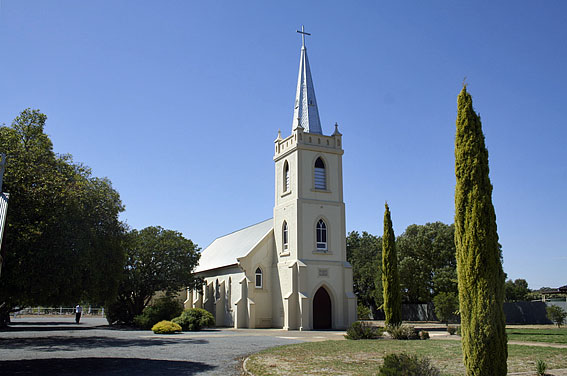
Immanuel Lutheran Church, Light Pass
[Photograph by Trevor Bunning (March 2009)]
Historical and Technical Documentation by David Shield
© OHTA 2009 (last updated September 2019)
The two Lutheran churches of Light Pass are separated by a matter of metres. In 1860, a disgruntled group had separated from the Immanuel congregation to form their own church to become known as Strait Gate, not 200 metres away. Both buildings and organs reflect progress. Whereas Strait Gate has retained its 1925 Dodd organ, Immanuel replaced its 1876 Lemke instrument with a Davis & Laurie instrument of 1962. On the other hand, Immanuel retains its 1886 building whereas Strait Gate has a stunning building designed in the 1960s by Otto Von Schrameck.
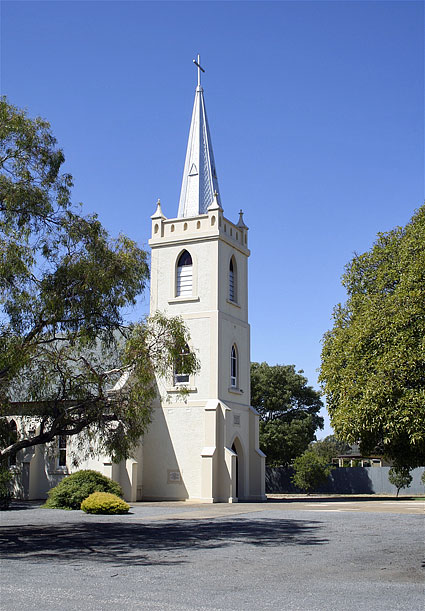 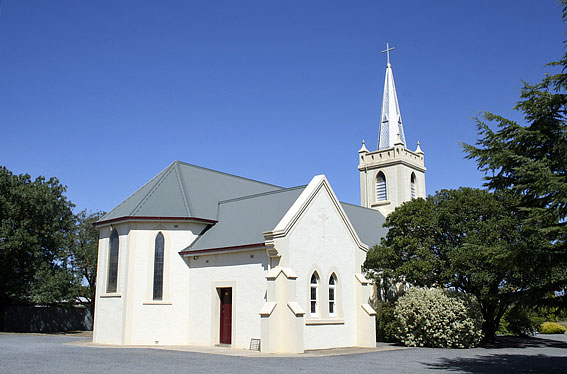 Immanuel Lutheran Church, Light Pass (dedicated November 1886) [Photograph by Trevor Bunning (March 2009) |
Light Pass is somewhat of a misnomer as there is no Pass as such. Colonel Light first explored the area in 1839 and was apparently looking for a way through the hills for travellers to the Murray. This was a point at which the Para River coming from the adjacent Hills could be conveniently crossed. German refugees that arrived in 1845 on the Patell largely settled the area. The congregation was formed in 1846 by Pastor Kavel with a school the first structure to be built.1
First Organ.
As elsewhere, the role of the school teacher was also that of church musician, many long serving. Lights Pass school was the third Barossan Lutheran school and was established in 1846 with their first teacher G.J. Rechner. Johann Lowke served as teacher for 43 years from 1866 to 1909 when the school closed. He was also the organist and bell ringer of Immanuel. The first church served as the school for some time.
Lowke resigned as organist and bell ringer after 66 years of continuous service at the Annual General Meeting of the church in January 1928. This led an anonymous writer to conclude that the organ, built by Daniel Lemke, was built and placed in the church in 1862.2 Assuming it would take some months to construct, it would have been during Lemke's first year of marriage and the birth of his first child, with a new teaching appointment pending at Eden Valley. It would also predate the Gruenberg organ of 1871 by some nine years. However, a brief history of Light Pass indicates it was placed in the church in 1876 during the tenure of Pastor Niquet (1865-1888).3
The current church was dedicated on 29 November 1886. The organ was partly dismantled, and transferred on to the gallery by teacher Lowke and one of his daughters, where it remained till 1961.4 Presumably it had been placed to the right of the pulpit in the old church.
The tower to the church was added in 1930 and a new bell, of steel, installed. Presented by J.C.F. Zeunert, it was fabricated by George V. Bochumer, of Verein Bochum, Germany. The bell has a single word inscribed with the date, "Immanuel" 1930 and rings the tone of G#. It measures 43" x 35" (1092mm x 889mm) and weighs 515kg. The bell swings on a rocking type of axle with teeth known in German as a Zahnkranz-Rollager, not uncommon in 19th century Germany but very rare in Australia. The first bell was given to the Lutheran church in Cummins.5
The Lemke organ is now placed in the church hall after its return from Frankston, Victoria in 2021. The wind reservoir and feeders were releathered by George Stephens at this time.
Present organ.
The annual meeting of the church in February 1959 determined the Lemke organ would sooner or later need to be replaced. Offerings in aid of a new organ were begun. In 1961 the half yearly meeting scheduled for August was adjourned to allow a detailed investigation and report concerning the feasibility of purchase. In September it was reported that a new organ could be purchased and erected on the gallery for £2000. The organ fund stood at £324.19.8. A long discussion ensued. One can only hazard a guess at the dynamics of the meeting. Finally, provided the old organ be taken, four unnamed members of the congregation were prepared to pay the balance. The resolution was taken for a new instrument.
The congregation had expectations the organ might be dedicated one month later, on 26 November, to coincide with the 75th anniversary of the church building. Not surprisingly "the makers could not complete it in time", and it was dedicated the following year.6
 The Davis & Laurie organ (1962) at Immanuel Lutheran Church [Photograph by Trevor Bunning (March 2009)] |
Built by Davis & Laurie Pty Ltd, of Melbourne, this organ was dedicated in January 1962. Of interest is the reversed colour of the keys with white sharps and black naturals. It is also the only organ in the Valley to possess a roller schwellen for progressively increasing or decreasing the sound. It has a single manual and no pedals. An electric action extension organ, it has 12 stops derived from three ranks of pipes, all visible in the case.
 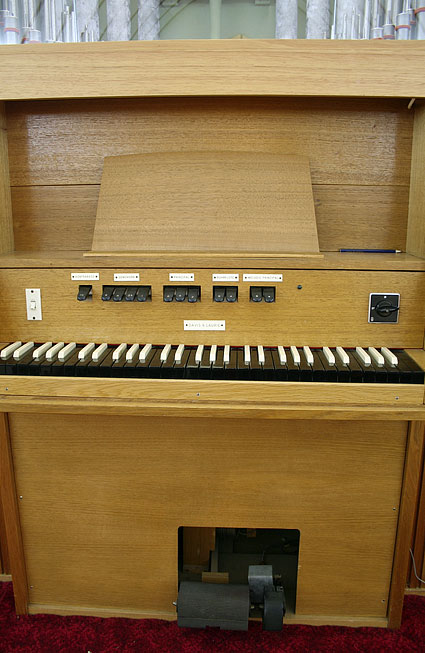 Casework and console of the Davis & Laurie organ [Photographs by Trevor Bunning (March 2009)] |
Because Steve Laurie felt very few could handle the idea of an extension organ, he experimented. To assist the organist, the stops were grouped according to the rank from which they were derived. There are three groups of stops so that the organist could see very well when they put on the Gemshorn 4ft, for example, they would know it was an extension of the Gemshorn 8ft, so it could be used more intelligently.
  Stopkeys of the Davis & Laurie organ [Photographs by Trevor Bunning (March 2009)] |
It has swell shutters in the roof and the front of the swell box has two sliding glass panels that can be slid back to provide an unenclosed organ, or closed using the expression on top.7
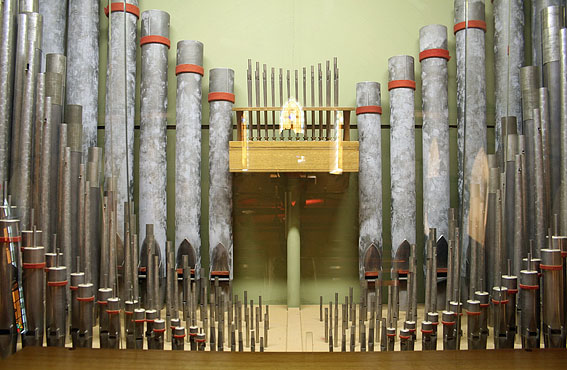 Pipework of the Davis & Laurie organ [Photograph by Trevor Bunning (March 2009)] |
| MANUAL Kontra bass Prinzipal Melodic Prinzipal Gemshorn Rohr Flute Prinzipal Melodic Prinzipal Gemshorn Rohr Flute Gemshorn Prinzipal Gemshorn |
16 8 8 8 8 4 4 4 4 2-2/3 2 1 |
(CC to tenor B) A gvd A B gvd C A A B C B A B |
Compass: 61 notes
Attached stopkey
console
Balanced
mechanical swell pedal
Rollschweller
_________________________________________________________________________
1 R.G. Munchenberg,
et.al., The Barossa A Vision Realised (1992), pp. 33-34, 198.
3 Brief History of Immanuel Lutheran Church Light Pass (n.d.)
4 Th. Hebart, The
United Evangelical Lutheran Church in Australia, (1938, 1985), p. 264; The Story of Two Bells, op.cit.
5 Ibid. Note, the converted Imperial measures
vary slightly from those given in Bagot, H., ‘Bells of the Barossa’, Journal
of Friends of Lutheran Archives,
no 10 (October 2000) p. 14; Ibid. p. 12. Other steel bells from the same foundry are found at St Michael’s
Gnadenfrei, Marananga (1913), St Petri, Nuriootpa (1926), St Thomas, Stockwell
(1929)
6 The Story of Two
Bells, op.cit.
7 B. Jefferson, Steve Laurie, Organ
Builder: His Life and Works (1998), pp. 73-74, 228.



Interior of Immanuel Lutheran Church, Light Pass
[Photographs by Trevor Bunning (March 2009)]